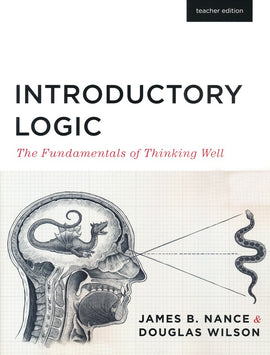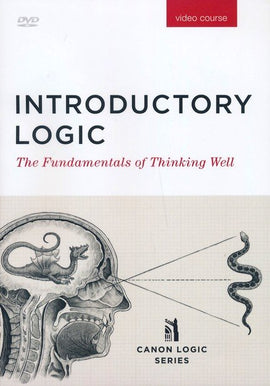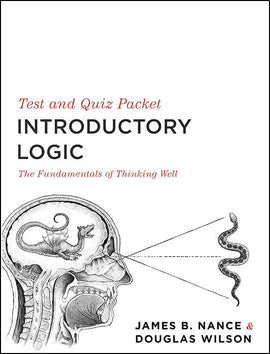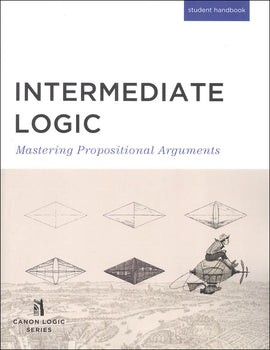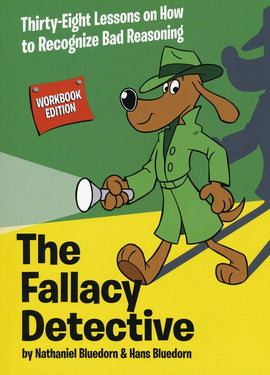Introductory Logic: The Fundamentals of Thinking Well Student Edition, 5th Edition
- How to properly define terms for maximum precision and accuracy -- and thus win the debate,
- How to form and interpret statements, the building blocks of logical thought,
- How to compose valid syllogisms, and -- just as importantly -- expose the invalid fakes using counterexamples,
- How to analyze arguments in normal English,
- How to identify and deflect informal fallacies (one of the most instantly applicable parts of logic),
- And much more!
Anybody can do Introductory Logic. Brand new, clean, easy-to-read layout, lots of margin notes for key points and further study, a step-by-step modern method, and exercises for every lesson (plus review questions and review exercises for every unit) all make Introductory Logic the perfect choice for establishing an in-your-bones knowledge of the fundamentals of thinking well.
Introductory Logic is perfect for Grade 7+ students, teachers, and parents who've never tackled syllogisms or fallacies before. It provides a semester or year's worth of logic to help you detect and deflect flawed or deceitful arguments and to think, debate, and argue well.
Click here to download the errata sheet for Introductory Logic.
Click each link to order the Teacher's Edition, Test and Quiz Packet or DVD.
About the Authors -
James B. Nance has taught at Logos School in Moscow, Idaho since 1990. He currently teaches logic, rhetoric, calculus, physics, and Christian doctrine. He has written articles for Classis and Credenda/Agenda, and he lectures regularly at the national conference for the Association of Classical Christian Schools. He and his wife Giselle have four children.
Douglas Wilson is the pastor of Christ Church, Moscow, Idaho, and editor of Credenda/Agenda magazine. He is the author of many books, including Recovering the Lost Tools of Learning, Reforming Marriage, and A Primer on Worship and Reformation. He is also co-author with Christopher Hitchens of Is Christianity Good for the World? A voracious reader (with a sweet tooth for Wodehouse), Douglas blogs prolifically at www.dougwils.com. He and his wife Nancy have three children and fifteen grandchildren.
Paperback, ISBN 9781591281658, 5th Edition, Perforated pages
SKU 1081658
| Book Title | Introductory Logic: The Fundamentals of Thinking Well Student Edition, 5th Edition |
| Publisher: | Canon Press, Logos Press & Noeo Homeschool Science |
| Author | Douglas Wilson, James Nance |
| ISBN |
- How to properly define terms for maximum precision and accuracy -- and thus win the debate,
- How to form and interpret statements, the building blocks of logical thought,
- How to compose valid syllogisms, and -- just as importantly -- expose the invalid fakes using counterexamples,
- How to analyze arguments in normal English,
- How to identify and deflect informal fallacies (one of the most instantly applicable parts of logic),
- And much more!
Anybody can do Introductory Logic. Brand new, clean, easy-to-read layout, lots of margin notes for key points and further study, a step-by-step modern method, and exercises for every lesson (plus review questions and review exercises for every unit) all make Introductory Logic the perfect choice for establishing an in-your-bones knowledge of the fundamentals of thinking well.
Introductory Logic is perfect for Grade 7+ students, teachers, and parents who've never tackled syllogisms or fallacies before. It provides a semester or year's worth of logic to help you detect and deflect flawed or deceitful arguments and to think, debate, and argue well.
Click here to download the errata sheet for Introductory Logic.
Click each link to order the Teacher's Edition, Test and Quiz Packet or DVD.
About the Authors -
James B. Nance has taught at Logos School in Moscow, Idaho since 1990. He currently teaches logic, rhetoric, calculus, physics, and Christian doctrine. He has written articles for Classis and Credenda/Agenda, and he lectures regularly at the national conference for the Association of Classical Christian Schools. He and his wife Giselle have four children.
Douglas Wilson is the pastor of Christ Church, Moscow, Idaho, and editor of Credenda/Agenda magazine. He is the author of many books, including Recovering the Lost Tools of Learning, Reforming Marriage, and A Primer on Worship and Reformation. He is also co-author with Christopher Hitchens of Is Christianity Good for the World? A voracious reader (with a sweet tooth for Wodehouse), Douglas blogs prolifically at www.dougwils.com. He and his wife Nancy have three children and fifteen grandchildren.
Paperback, ISBN 9781591281658, 5th Edition, Perforated pages
SKU 1081658













